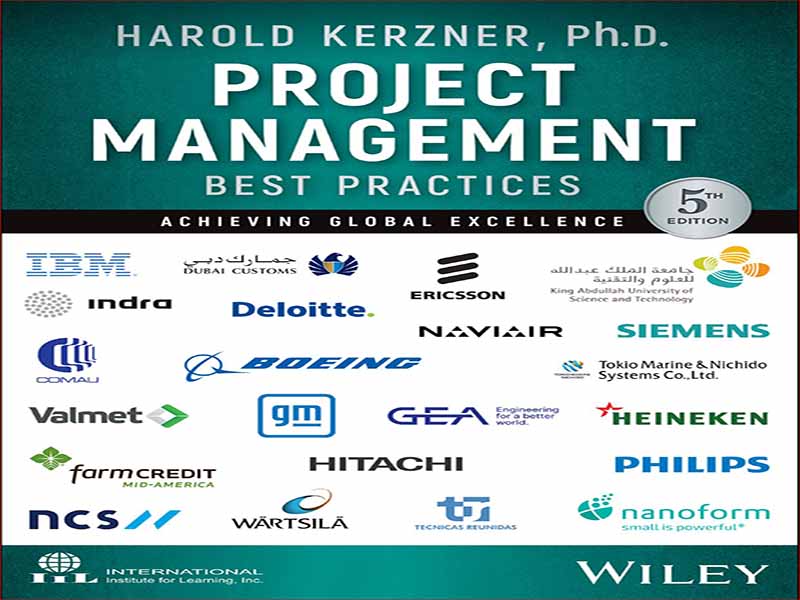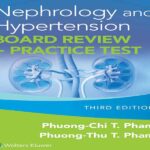- عنوان: Project Management Best Practices
- نویسنده: Harold Kerzner
- حوزه: مدیریت پروژه
- سال انتشار: 2024
- تعداد صفحه: 734
- زبان اصلی: انگلیسی
- نوع فایل: pdf
- حجم فایل: 15.4 مگابایت
برای تقریباً 50 سال، مدیریت پروژه به عنوان فرآیندی تلقی می شد که ممکن است داشتن آن خوب باشد، اما نه فرآیندی که برای بقای شرکت ضروری باشد. شیوههای مدیریت پروژه در بسیاری از شرکتها به پروژههای سنتی یا عملیاتی با حوزههای کاملاً مشخص محدود میشد تا فعالیتهای استراتژیک یا نوآورانه که ممکن است فقط بر اساس یک ایده یا هدف استراتژیک تجاری باشد. شرکتها با اکراه در برخی دورههای آموزشی سرمایهگذاری کردند تا صرفاً دانش اولیه برنامهریزی و زمانبندی را به کارکنان خود ارائه دهند. مدیریت پروژه به عنوان تهدیدی برای خطوط قدرت مستقر تلقی می شد و در بسیاری از شرکت ها، فقط مدیریت پروژه جزئی مورد استفاده قرار می گرفت. این پیادهسازی بیاهمیت صرفاً برای آرام کردن پرسنل سطح پایین و متوسط و همچنین مشتریان منتخب اتفاق افتاد. در طول این دوره 50 ساله، بسیاری از شرکت ها تمام تلاش خود را برای جلوگیری از تعالی در مدیریت پروژه انجام دادند. شرکتها فقط به توانمندسازی، کار تیمی و اعتماد پاسخ میدادند. آنها اطلاعات را احتکار کردند زیرا کنترل اطلاعات به عنوان قدرت تلقی می شد. آنها در سلسله مراتب اولویت ها، از جمله نوآوری و سایر نیازهای استراتژیک، منافع شخصی و عملکردی را مقدم بر منافع شرکت قرار دادند و این باور نادرست را حفظ کردند که زمان به جای محدودیت، یک تجمل است. در اواسط دهه 1990، این ذهنیت عمدتاً به دلیل دو رکود شروع به فروکش کرد. شرکت ها برای ایجاد محصولات جدید با کیفیت بالا در مدت زمان کوتاه تری تحت فشار شدید رقابتی قرار داشتند. اکنون نوآوری یک ضرورت برای رشد و بقا تلقی می شد. اهمیت ایجاد یک رابطه اعتماد طولانی مدت با مشتریان در خط مقدم قرار گرفته بود زیرا مشتریان خواهان نوآوری های بیشتری بودند. کسب و کارها توسط ذینفعان مجبور به تغییر برای بهتر شدن و تبدیل شدن به نوآوری می شدند. اکنون بقای شرکت در خطر بود. امروزه، کسبوکارها به سمت بهتر شدن تغییر کردهاند و مدیریت پروژه نوآورانه بخش بزرگی از تغییر بوده است. اعتماد بین مشتری و پیمانکار و همچنین اعتماد بین مدیریت و تیم پروژه در بالاترین حد خود قرار دارد. محصولات جدید ناشی از شیوه های مدیریت پروژه بهتر با سرعتی سریعتر از همیشه در حال توسعه هستند. شیوه های مدیریت پروژه نوآوری به یک سلاح رقابتی در طول مناقصه رقابتی تبدیل شده است. برخی از شرکت ها به دلیل ایمانی که مشتری به توانایی پیمانکار برای ارائه جریان مستمر پروژه های موفق با استفاده از روش مدیریت پروژه دارد که امروزه بیشتر شبیه یک چارچوب یا متدولوژی انعطاف پذیر به نظر می رسد، قراردادهایی با منبع انحصاری برای محصولات و خدمات نوآورانه دریافت می کنند. رویکرد سفت و سخت همه این عوامل به بسیاری از شرکت ها اجازه داده است تا به درجه ای از برتری در مدیریت پروژه دست یابند. تصمیمات تجاری در حال حاضر قبل از تصمیمات شخصی مورد تاکید قرار می گیرند. کلماتی که 20 سال پیش رایج بودند، امروزه معانی جدیدی پیدا کرده اند. تغییر ناشی از اجرای بهتر پروژه دیگر کاملاً بد تلقی نمی شود. امروزه تغییر مستلزم بهبود مستمر است. درگیری ها دیگر مضر تلقی نمی شوند. تعارض هایی که به خوبی مدیریت می شوند می توانند سودمند باشند. مدیریت پروژه دیگر به عنوان یک سیستم کاملاً داخلی در سازمان دیده نمی شود. ممکن است به مشارکت های استراتژیک نیاز باشد. مدیریت پروژه اکنون یک سلاح رقابتی است که سطوح بالاتری از کیفیت و فرصتهای ارزش افزوده را برای مشتری به ارمغان میآورد. در بسیاری از شرکت ها، مدیریت پروژه به عنوان یک شایستگی استراتژیک در نظر گرفته می شود که یکی از چهار یا پنج مسیر شغلی در شرکت است که برای آینده شرکت حیاتی است. شرکت هایی که در گذشته در مدیریت عالی تلقی می شدند، ممکن است امروزه دیگر عالی در نظر گرفته نشوند، به خصوص در مورد مدیریت پروژه. کتابی با عنوان در جستجوی تعالی را در نظر بگیرید که توسط تام پیترز و رابرت واترمن در سال 1982 نوشته شده است (منتشر شده در نیویورک توسط Harper & Row). چه تعداد از شرکتهایی که در کتابشان شناسایی شدهاند، امروزه هنوز عالی در نظر گرفته میشوند؟ چه تعداد از آن شرکت ها برنده جایزه معتبر مالکوم بالدریج شده اند؟ چه تعداد از آن شرکت هایی که برنده این جایزه شده اند امروزه در مدیریت پروژه عالی هستند؟ تعالی در مدیریت پروژه یک سفر بی پایان است. شرکت هایی که تمایلی به سرمایه گذاری در بهبود مستمر مدیریت پروژه ندارند، به زودی با رتبه پایین رضایت مشتری مواجه می شوند. این کتاب مباحث پیشرفته مدیریت پروژه لازم برای پیاده سازی و تعالی در مدیریت پروژه را پوشش می دهد. این کتاب حاوی نقل قول های متعددی از افراد در این زمینه است که بهترین شیوه ها را در مدیریت پروژه محک زده اند و در حال حاضر در حال اجرای این فرآیندها در شرکت های خود هستند. نقل قول های این کتاب توسط چندین افسر ارشد شرکت و همچنین دیگران ارائه شده است.
For almost 50 years, project management was viewed as a process that might be nice to have but not one that was necessary for the survival of the firm. Project management practices were restricted in many companies to traditional or operational projects with well-defined scopes rather than strategic or innovation activities that may be based upon just an idea or strategic business objective. Companies reluctantly invested in some training courses simply to provide their personnel with basic knowledge of planning and scheduling. Project management was viewed as a threat to established lines of authority, and in many companies, only partial project management was used. This halfhearted implementation occurred simply to placate lower-and middle-level personnel as well as select customers. During this 50-year period, many companies did everything possible to prevent excellence in project management from occurring. Companies provided only lip service to empowerment, teamwork, and trust. They hoarded information because the control of information was viewed as power. They placed personal and functional interests ahead of the best interest of the company in the hierarchy of priorities, including innovation and other strategic necessities, and maintained the faulty belief that time was a luxury rather than a constraint. By the mid-1990s, this mentality began to subside, largely due to two recessions. Companies were under severe competitive pressure to create new high-quality products in a shorter period of time. Innovation was now considered a necessity for growth and survival. The importance of developing a long-term trusting relationship with the customers had come to the forefront as customers wanted more innovations. Businesses were being forced by the stakeholders to change for the better and become innovative. The survival of the firm was now at stake. Today, businesses have changed for the better, and innovative project management was a large part of the change. Trust between the customer and contractor is at an all-time high as well as trust between management and the project teams. New products resulting from better project management practices are being developed at a faster rate than ever before. Innovation project management practices have become a competitive weapon during competitive bidding. Some companies are receiving sole-source contracts for innovative products and services because of the faith that the customer has in the contractor’s ability to deliver a continuous stream of successful projects using a project management methodology that today appears more like a framework or flexible methodology than a rigid approach. All of these factors have allowed a multitude of companies to achieve some degree of excellence in project management. Business decisions are now being emphasized ahead of personal decisions. Words that were commonplace 20 years ago have taken on new meanings today. Change resulting from better project execution is no longer being viewed as being entirely bad. Today, change implies continuous improvement. Conflicts are no longer seen as detrimental. Conflicts managed well can be beneficial. Project management is no longer viewed as a system entirely internal to the organization. Strategic partnerships may be required. Project management is now a competitive weapon that brings higher levels of quality and increased value-added opportunities for the customer. In many companies, project management is treated as a strategic competency that is one of the four or five career paths in the company that are critical for the company’s future. Companies that were considered excellent in management in the past may no longer be regarded as excellent today, especially with regard to project management. Consider the book entitled In Search of Excellence, written by Tom Peters and Robert Waterman in 1982 (published in New York by Harper & Row). How many of the companies identified in their book are still considered excellent today? How many of those companies have won the prestigious Malcolm Baldrige Award? How many of those companies that have won the award are excellent in project management today? Excellence in project management is a never-ending journey. Companies that are reluctant to invest in continuous improvements in project management soon find themselves with low customer satisfaction ratings. This book covers the advanced project management topics necessary for implementation of and excellence in project management. The book contains numerous quotes from people in the field who have benchmarked best practices in project management and are currently implementing these processes within their own firms. Quotes in this book were provided by several senior corporate officers as well as others.
این کتاب را میتوانید بصورت رایگان از لینک زیر دانلود نمایید.
Download: Project Management Best Practices



































نظرات کاربران